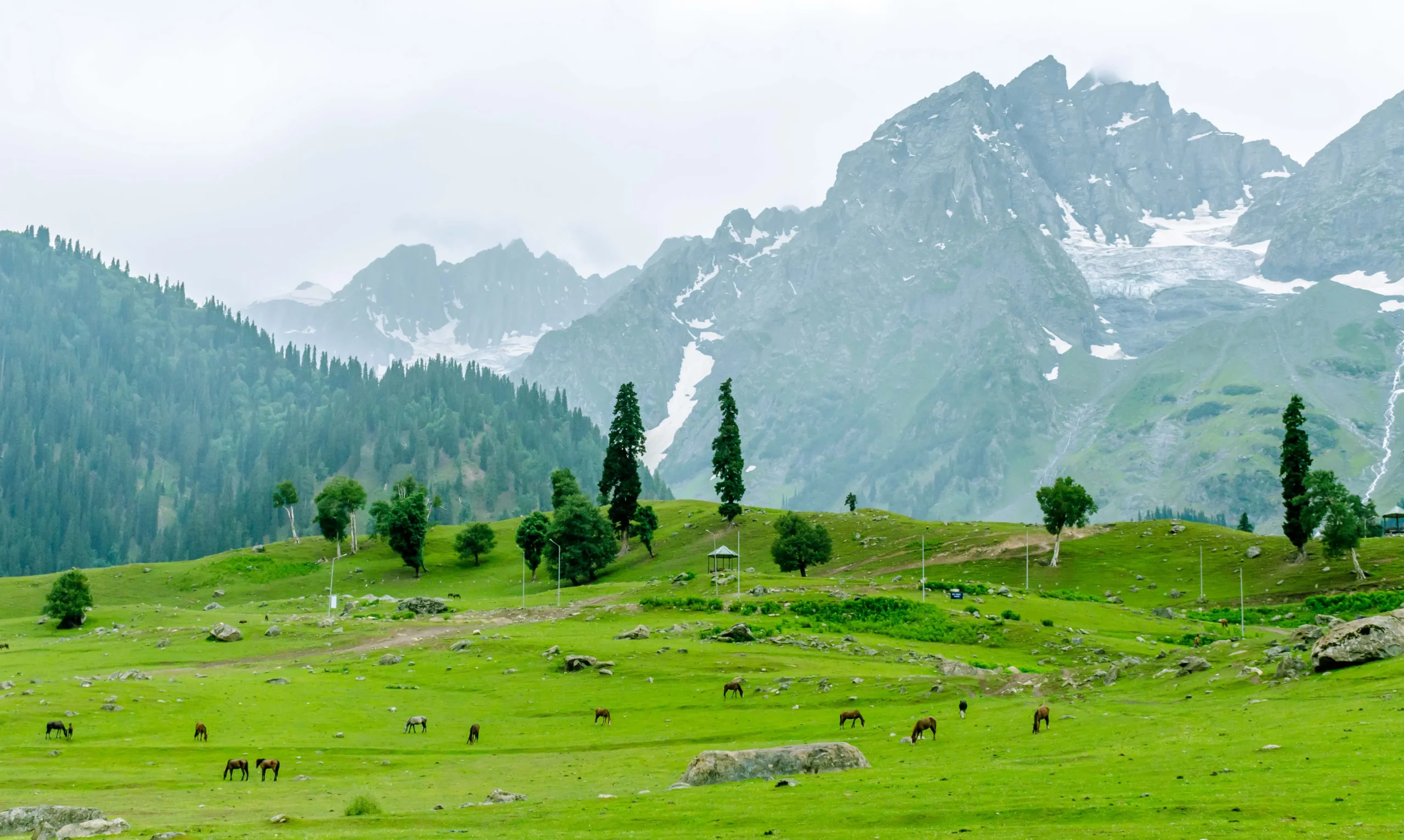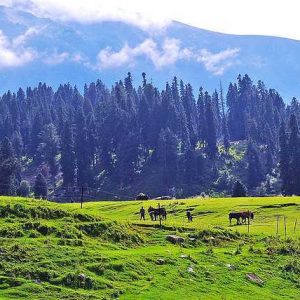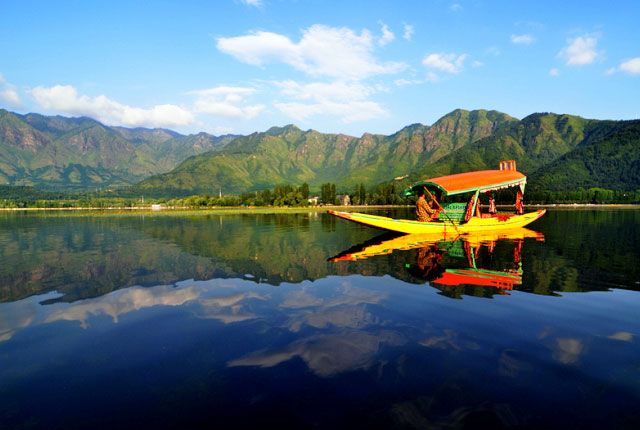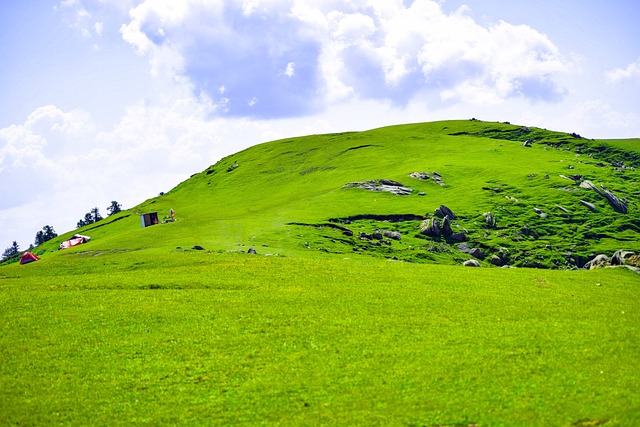
Best Time to Visit Sonamarg
Table of Contents
ToggleOverview
Surrounded by the majestic Himalayas, Sonamarg, commonly known as the “Meadow of Gold,” is a stunning tapestry of white-peaked mountains, green meadows, and glacial streams. When organizing your holiday of a lifetime, understanding the ideal time to visit Sonamarg can be the key to making your sojourn truly comfortable or an expedition riddled with uncertain weather conditions. Whether you’re pursuing colorful wildflowers, taking an adventurous hike to Thajiwas Glacier, or merely basking in the tranquil loveliness of Sonamarg Valley, timing is of the essence. In this complete guide, we’ll learn about Sonamarg’s climate, seasonal features, and insider secrets to plan the ideal trip.





Understanding Sonamarg: The Meadow of Gold
Sonamarg lies at an altitude of about 2,800 meters (9,200 ft) in the Ganderbal district of the state of Jammu & Kashmir. Encircled by giant Himalayan peaks, Sonamarg is a portal to some of the state’s most renowned trekking routes like the Baltoro Glacier trek and the Zojila Pass trail. The Sonamarg Valley is traversed by the Sindh River whose aquamarine waters mirror the giant peaks and green alpine meadows.
Major draws of Sonamarg are:
- Thajiwas Glacier: A favorite day-trip destination with ice caves and snowfields even in summer.
- Nilagrad River Garden: Renowned for its jade-green stream nourished by the melt of glaciers.
- Gadsar Lake and Vishansar Lake: High-altitude lakes perfect for multi-day hikes.
- Zoji La Pass: A cinematic mountain pass linking Sonamarg to Leh.
Sonamarg Climate and Weather Patterns
Sonamarg has a high-altitude temperate climate with cool summers and harsh winters. The weather is unpredictable, so it’s crucial to know the seasonal trends:
- Spring (March to May): Slow warming, snowmelt, appearance of wildflowers.
- Summer (June to August): Tourist season peak time, clear skies, green meadows.
- Autumn (September to November): Sharp air, vibrant colors, fewer tourists.
- Winter (December to February): Heavy snowfall, Leh–Manali Highway frequently closed, perfect for snow sports enthusiasts.
Average temperature ranges:
- Winter: −5°C to 5°C
- Spring: 0°C to 15°C
- Summer: 10°C to 20°C
- Autumn: 5°C to 18°C
Seasonal Breakdown: When to Visit Sonamarg
Spring (March–May)
Spring sees Sonamarg come to life. With snow slowly melting away, the scenery turns into a kaleidoscope of colors with alpine flowers like primulas, forget-me-nots, and buttercups in bloom. Sonamarg is best explored by photographers and nature enthusiasts during late April to early May, when the climate is pleasant and trekking routes to Thajiwas Glacier start to open.
Highlights:
- Meltwater streams such as the Sindh River roaring with glacial runoff.
- Less tourists than during summer months.
- Perfect for day trips to nearby meadows and waterfalls.
Summer (June–August)
Summer is the peak tourist season without any doubt in Sonamarg, with warm daytime weather and clear mountain views. With relatively cloudless skies, this is the ideal time for Sonamarg trekking adventures, from the arduous trails to Vishansar Lake, Gadsar Lake, and further.
Highlights:
- Comfortable temperatures (10°C–20°C) ideal for camping and trekking.
- Access to high-altitude passes such as Zojila.
- Vibrant greenery and full-flowing waterfalls.
Autumn (September–November)
Autumn brings crisp, clear air and spectacular landscapes painted in shades of gold, amber, and russet. If escaping summer crowds and experiencing the best time to visit Sonamarg for solitude appeals to you, consider a trip in early September. By October, nights grow chilly, but the daylight remains pleasant for exploration.
Highlights:
- Breathtaking fall colors along the Sindh River banks.
- Falling rates on accommodations and tour packages.
- Excellent photography visibility.
Winter (December–February)
Sonamarg in winter is a world of heavy snow and frozen waterfalls, turning the valley into a snow wonderland. Though roads are closed in most places due to heavy snowfall, explorers of snow trekking and skiing can still approach Sonamarg by special convoy from Srinagar.
Highlights:
- Snow-covered meadows perfect for snowshoeing and ice skating.
- Chance to see snow leopards and Himalayan brown bears in their winter home.
- Exclusive winter festivals and local Kashmiri hospitality.
Month-by-Month Guide: Best Months to Visit Sonamarg
Month | Weather | Key Activities | Crowds & Costs |
March | 0°C–5°C, thawing snow | Early wildflower spotting | Low crowds, discounted stays |
April | 5°C–12°C, budding meadows | Nature walks, photography | Moderate crowds |
May | 10°C–15°C, clear trails | Trek start points open, camping | Rising rates, good deals |
June | 12°C–18°C, summer peak | Long treks, river rafting | High crowds, premium prices |
July | 15°C–20°C, monsoon risk | Glacial hikes, fishing | Maximum influx, high costs |
August | 14°C–19°C, stable skies | Adventure sports, meadow picnics | Crowded, book in advance |
September | 10°C–16°C, crisp mornings | Autumn photography, bird watching | Moderate crowds, lower prices |
October | 5°C–12°C, cool days | Solo treks, local festivals | Low crowds, discounted tours |
November | 0°C–8°C, first snow | Snow treks, cultural experiences | Very low crowds, low rates |
December | −5°C–2°C, heavy snow | Snowshoeing, ice skating | Roads closed, niche tourism |
January | −10°C–0°C, deep snow | Winter camping, observatory visits | Almost no tourists |
Top Activities in Sonamarg by Season
Spring Adventures
- Bloom Trails: Stroll through flower-covered fields near Zoji La base.
- Photography Tours: Get up close with rare Himalayan plants.
- Riverside Camping: Set up camp at the thawing banks of the Sindh River.
Summer Escapades
- Thajiwas Glacier Trek: Easy day trek to visit glacier caves.
- River Rafting: Nav grade II and III rapids on the Sindh River.
- High-Altitude Lakes: Multi-day treks to Vishansar, Krishansar, and Gadsar Lakes.
Autumn Excursions
- Bird Watching: Identify migratory species like Himalayan monal.
- Cultural Walks: Explore traditional shepherd camps and learn Kashmiri crafts.
- Scenic Drives: Soak up panoramic views on the way to Drung Waterfall.
Winter Wonders
- Snow Trekking: Trek to frozen meadows on snowshoes.
- Ice Skating and Sledging: Discover natural rinks close to the village center.
- Photography: High-contrast, dramatic winter landscapes.
Planning Your Trip: Sonamarg Tour Packages and Itineraries
When reserving Sonamarg tour packages, ask yourself if you would like a guided tour or a self-drive option. Various operators package Srinagar–Sonamarg tours with houseboat stays and day excursions to Gulmarg. Standard 3- to 5-day itineraries are as follows:
Day 1: Arrival in Srinagar, shikara cruise on Dal Lake, drive to Sonamarg in the evening.
Day 2: Thajiwas Glacier outing, horse riding, Kashmiri meal.
Day 3: Full-day trek to Vishansar Lake or day of leisure visiting meadows.
Day 4: Return to Srinagar via Zoji La Pass, optional detour at Dras War Memorial.
Day 5: Day of departure or further travel to Leh.
Budget travelers have shared taxis and government-run rest houses as affordable options. Luxury travelers can choose riverside glamping tents with all amenities.
How to Reach Sonamarg: Travel Tips and Routes
By Air
Closest Airport: Srinagar International Airport (SXR) is about 80 kilometers from there.
Flight Connectivity: Sustained flights from Delhi, Mumbai, and other important Indian cities.
Transfer: Private taxi or shuttle buses from the airport to Sonamarg.
By Road
From Srinagar: The 80 km Srinagar–Sonamarg road (NH1D) is well connected during summer and autumn seasons.
From Leh: Open via Zoji La Pass; open usually from June to October.
Winter Convoys: Special armed convoys operate from Srinagar to Sonamarg a couple of days a week; pre-booking is a must.
By Rail
Nearest Railway Station: Jammu Tawi, approximately 300 km away.
Alternate: Travel by train to Udhampur or Baramulla and then by road.
Travel Tip: During monsoon months (July–August), watch for weather bulletins and road condition reports. Landslides sometimes cause disruption on NH1D, so include buffer days in your schedule.
Accommodation Options in Sonamarg Valley
Sonamarg has something to suit every range of budgets and tastes:
- Budget Guesthouses: Simple rooms with common bathrooms, usually owned and operated by local families.
- Mid-Range Hotels: Cozy rooms, in-house restaurant, and activity bookings arranged.
- Riverside Camps: Luxury tents with washrooms attached, bonfire area, and gourmet food.
- Houseboats (Srinagar side): For an experience of both Dal Lake and Sonamarg combined.
Booking Tip: Summer dates get booked in advance. For the ideal time to visit Sonamarg, book your accommodation at least 2–3 months prior, if you are planning to visit during June, July, or August.
Sonamarg Packing Essentials for Adventures
Come rain or shine, Sonamarg’s high-altitude weather requires intelligent packing. Here’s a season-wise packing list:
Item | Spring & Autumn | Summer | Winter |
Warm Layers | Fleece jacket, thermal wear | Light fleece, windcheater | Heavy-duty down jacket, thermals |
Rain Gear | Waterproof shell, umbrella | Waterproof jacket, quick-dry wear | N/A |
Footwear | Waterproof hiking boots | Trekking shoes, sandals for camps | Insulated boots, gaiters |
Accessories | Sunglasses, sunhat | Sunblock, wide-brim hat | Woolen cap, gloves, scarf |
Optional | Trekking poles, camera gear | River sandals, fishing rod | Snowshoes, crampons |
Medication | Altitude sickness tablets, basic first-aid kit |
|
Health and Safety Tips for Sonamarg
Acclimatize Properly
Sonamarg sits at nearly 2,800 meters. Spend your first day doing light activities to avoid acute mountain sickness (AMS).
Stay Hydrated
High-altitude dehydration can sneak up on you. Drink at least 3–4 liters of water daily.
Local Guidelines
Respect Kashmiri tradition and dress conservatively. Take local advice prior to venturing into the remote zones.
Wildlife Precautions
Though wildlife sightings are uncommon in the vicinity of the major village, take food precautions at all times to avoid attracting Himalayan brown bears.
Frequently Asked Questions about Visiting Sonamarg
Q: What is the best time to visit Sonamarg for clear views?
A: Late May to early September provides the best skies and least rainfall, so it is the best time window for having breathtaking mountain scenery.
Q: Is there anything restricted for foreign travelers?
A: No permit is needed for Sonamarg per se, but if your trek extends beyond, like Zanskar or Ladakh, you can do with an Inner Line Permit.
Q: How many days are sufficient to see Sonamarg?
A: A 2–3 day visit includes key places such as Thajiwas Glacier and a brief trek, while a 5–7 day tour provides for longer treks to high-altitude lakes.
Q: Can I drive to Sonamarg myself?
A: Yes, but expect narrow mountain roads and rapid changes in the weather. Keep your vehicle in good condition and take extra petrol.
Q: What local food should I eat?
A: Do not miss Kashmiri delicacies like Rogan Josh, Dum Aloo, and hot Kahwa tea to warm up the cold.
Conclusion: Making the Most of Your Sonamarg Journey
Selecting the optimum season to visit Sonamarg is based on your preference—be it the colorful flowers of spring, the activity-filled summer, the peaceful charm of fall, or the untainted snows of winter. Every season has its own special beauty, be it hiking the Thajiwas Glacier, capturing golden autumn fields through the lens, or sailing over frozen terrain. With some advance planning, smart bookings, and suitable packing, you can tap into the entire magic of this Himalayan gem. So put on your hiking shoes, charge up that camera, and fix your compass towards Sonamarg—where every bend brings you a new postcard-perfect opportunity.
How to book Kashmir tour?
Contact a travel agency that specializes in Kashmir tours. You can reach out to the following for assistance:
- Phone:
- +91 7889 655596
- +91 7006 891267
- Email:
Inquire about tour packages, itineraries, and pricing, and confirm your booking for a memorable winter experience!
People Also Ask
What is the best time to visit Sonamarg?
The best time to visit Sonamarg is from late May to early September, when the weather is clear, the meadows are lush green, and trekking to Thajiwas Glacier or high-altitude lakes like Vishansar and Gadsar is most enjoyable.
How do I reach Sonamarg from Srinagar?
You can reach Sonamarg from Srinagar by a scenic 80 km drive along NH1D. Shared taxis, private cabs, and summer bus services run daily between Srinagar and Sonamarg.
Do I need any permit to visit Sonamarg?
No special inner-line permits are required for Sonamarg Valley itself—but if you plan to cross Zoji La into Ladakh or Zanskar, you’ll need an Inner Line Permit obtainable online or at designated government offices.
What are the top things to do in Sonamarg?
Key activities include trekking to Thajiwas Glacier, river rafting on the Sindh River, day-treks to Vishansar and Gadsar Lakes, camping by the river, and bird-watching in alpine meadows.
How many days should I plan for a Sonamarg trip?
A 2–3 day itinerary covers major highlights like Thajiwas Glacier and local meadows, while 5–7 days allow for longer treks to high-altitude lakes and off-the-beaten-path excursions.
What is the climate like in Sonamarg?
Sonamarg has a high-altitude temperate climate: cool summers (10 °C–20 °C), crisp autumns, mild springs, and severe winters (down to −10 °C) with heavy snowfall.
Is Sonamarg open in monsoon season?
Sonamarg remains accessible in July–August, but landslides and roadblocks can occur. Always check local weather and road condition updates before traveling during the monsoon.
Are there guided trekking packages in Sonamarg?
Yes—numerous operators offer guided Sonamarg trekking packages ranging from day hikes to multi-day expeditions to Vishansar, Krishansar, and Gadsar Lakes.
Where can I stay in Sonamarg?
Options include budget guesthouses, mid-range hotels, riverside glamping camps, and – for a combined Srinagar/Sonamarg trip – houseboats on Dal Lake with a day-trip to Sonamarg.
Is mobile network available in Sonamarg?
Most major Indian carriers like Jio and Airtel provide 4G connectivity in Sonamarg village, though signal may drop on higher-altitude treks and in narrow valleys.
How safe is Sonamarg for solo travelers?
Sonamarg is generally safe—local police and guides are accustomed to tourists. Always share your trekking itinerary, carry a charged phone, and avoid remote areas after dark.
What should I pack for Sonamarg in summer?
Pack light layers: thermal innerwear, a waterproof windcheater, sturdy trekking boots, sunhat, sunglasses, sunscreen, and a basic first-aid kit for altitude adjustment.
Can I self-drive to Sonamarg?
Yes—self-drive is popular among adventure seekers. Ensure your vehicle is serviced, carry extra fuel, and be prepared for steep gradients and occasional landslide-prone stretches.
Are there ATMs and medical facilities in Sonamarg?
Sonamarg has a small ATM kiosk and a primary health center. For serious emergencies, the nearest full-service hospital is in Kangan, about 20 km away.
What wildlife can be spotted around Sonamarg?
While rare near populated areas, you may spot Himalayan marmots, Himalayan monal pheasants, and – in remote valleys – signs of brown bears or snow leopards during winter.
How do I avoid altitude sickness in Sonamarg?
Acclimatize by spending your first 24 hours at lower elevation, stay hydrated (3–4 L/day), avoid alcohol, and carry prophylactic medications like acetazolamide if you’re prone to AMS.
What local cuisine should I try in Sonamarg?
Don’t miss Kashmiri staples like Rogan Josh, Dum Aloo, Modur Pulao, and the warming Kahwa tea, served at village homestays and riverside camps.
Are pets allowed in Sonamarg?
Most hotels and camps allow pets on request; however, trekking routes like Thajiwas Glacier may not be pet-friendly due to rough terrain and wildlife.
Can I do river rafting in Sonamarg?
Yes—river rafting on the Sindh River is available from Grade II to III rapids between Sonamarg and Ganderbal, usually operating from June through September.
What is the cost of a guided trek to Vishansar Lake?
A 2-day guided trek to Vishansar Lake typically costs ₹3,500–₹5,000 per person, including permits, guide, basic camping gear, and meals.
How do I book Sonamarg accommodation online?
Use popular booking platforms or local tour operator websites; for peak season (June–August), reserve at least 2–3 months in advance to secure riverside camps or premium hotels.
Is Sonamarg suitable for families with children?
Yes—day trips to Thajiwas Glacier and riverside picnics are family-friendly. Avoid long treks or winter convoys with very young children.
What are the best photography spots in Sonamarg?
Top spots include the Snow Viewpoint above the village, Thajiwas Glacier’s ice caves, scenic bridges over the Sindh River, and the contrast of golden meadows in autumn.
How does Sonamarg compare to Gulmarg?
While Gulmarg is famous for its golf course and winter skiing, Sonamarg caters more to trekkers and high-altitude adventurers seeking access to glacial lakes and remote passes.
Can I extend my trip from Sonamarg to Leh?
Yes—by crossing Zoji La Pass (open June–October), you can continue your journey from Sonamarg to Leh over a dramatic 350 km route, stopping at Dras, Kargil, and scenic viewpoints along the way.




